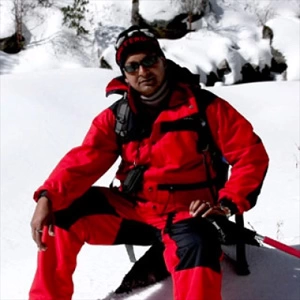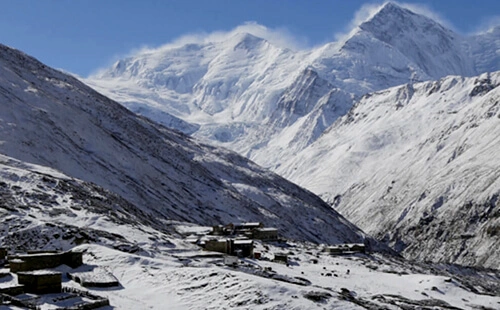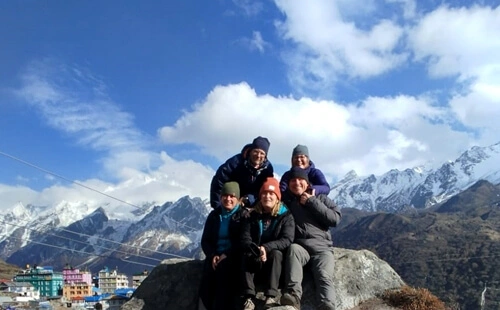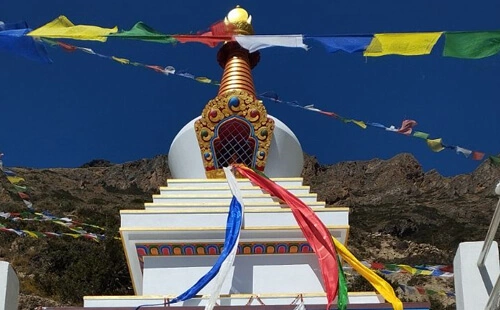Why is the Annapurna Circuit the greatest hiking trail?
Understanding why the trekking route is the very base of the ultimate around Annapurna Trek Guide. Considered a convenient option for seasoned trekkers seeking extraordinary adventure in the Annapurna Himalayas that also features easygoing hiking trails like the Ghorepani Poon Hill Trek, Khopra Danda Trek, and Mardi Himal Trek, the Annapurna Circuit Hike is along the deepest gorge in the world, Kali Gandaki Gorge.
From the dense forests to the Tibetan plateau-like landscape with minimal vegetation, expect steep ascents and descents. Particularly strenuous in high-altitude landmarks such as Thorong La Pass (5,416 m) above sea level, the entire trekking route is filled with stunning mountain views. While some sections demand excellent mental resilience, it also functions as an incredible ingredient for a deep sense of achievement.
Where is the Annapurna Circuit Trekking in Nepal?
While the exact Annapurna Trek distance is variable based on the trek starting point, as recent road extensions give you choices of whether to begin from Besisahar, Bhulbhule, Jagat, or Dharapani, the journey is through the Annapurna region of central Nepal within the Annapurna Conservation Area (ACA). Officially, it begins with a joyous drive, and the original circuit covers approximately 230 km (145 miles).
If you are short on time, you can also opt for a scenic flight to Jomsom, which is otherwise a gradual ascent from Besishar along the Kali Gandaki Gorge, and if following the modern route, you will cover a distance between 160 km (100 miles) - 190 km (118 miles) in about 12 to 16 days. Physical and mental conditioning become essential with the increased altitude, ruggedness, and remoteness of the terrain.
The standard Annapurna Circuit Trekking Itinerary
At Adventure Himalayan Travels and Treks, we are offering the standard Annapurna Circuit Trek itinerary of 15 days, which includes the spare days in the Kathmandu Valley and Manang en route, so you are used to the Himalayan weather and can make it successfully through the high-altitude Thorong La Pass. After you arrived in Nepal and UNESCO World Heritage Site Sightseeing in Kathmandu, you hit the trail.
I.e., on the third day, drive from Kathmandu to Besisahar and then to Syange. From here, you walk through Dharapani, Chyamje, Pisang, Manang, Yak Kharka, and Dharamsala, and cross the Thorong La Pass to Muktinath. From Muktinath is a descending trail to Jomsom to board a drive or flight back to Pokhara the next day. Like this, it ensures you a balanced journey, making its spot in the best Annapurna trek, including in the years 2026 and 2027.
What are the major highlights of the trek to the Annapurna Circuit?
The Annapurna Round Trek Guide helps you make the best out of the major attractions of the Annapurna Himalayas, perfect balance of challenge, spirituality, and natural charm. The stunning mountain views of the Annapurna ranges, which include Annapurna I (8,091 m), Dhaulagiri (8,167 m), and the iconic Machhapuchre (Fishtail), along with distant views of Manaslu Peak, keep you thrilled, where every step you take ensures a unique perspective.
The subtropical forests, some with streams, rivers, and cascading waterfalls, provide a serene nature walk, where the traditional villages offer you insight into the Himalayan lifestyle as well as a golden opportunity to experience genuine hospitality. Thorong La Pass is the highest Annapurna Trek altitude, and the village of Manang, showcasing strong Tibetan influence, followed by Muktinath Temple, presents you with cultural and spiritual dimensions.
When to go for the Annapurna Circuit hiking?
To conquer the Annapurna Trek height and the Annapurna Trek distance safely, including hiking several days at 3,000 m above sea level, where the presence of oxygen decreases with the gain in altitude and Himalayan weather gets unpredictable, booking your Annapurna Circuit Trek at the optimal time is a must. Hence, one of the tips for the round Annapurna Trek is to book in spring (March to May) and autumn (September to November).
Spring comes with the fresh bloom of rhododendron, vibrant valleys, and pleasant weather, while autumn, including the Annapurna Trek in November, is famous for crisp air, crystal-clear skies, and dry trekking trail conditions with moderate temperatures. Winter is with fewer crowds but potentially icy and snowy routes; preparation becomes essential, while summer means frequent rainfall; the northern section (Manang) remains drier.
Food and accommodation on the trekking trail
The guide for the trek around Annapurna is incomplete without information on what to expect on food, accommodation, and other comforts. Now, one of the popular teahouse trekking routes in Nepal, trekkers and climbers stay in teahouses. In general, it provides you with basic rooms, often twin-sharing beds, beddings, and daily meals, including breakfast, lunch, and dinner. Menus are simple but hearty, adequate to keep you energized.
While wifi, hot showers, and charging of electronic devices like cell phones, cameras, and AirPods are things of luxury in such an Annapurna Trek distance and Annapurna Trek altitude, in low altitude and larger villages, you can usually find them at some extra cost. With increased altitude, the internet services can get unreliable; therefore, it is advisable to buy a local SIM card like the Ncell or NTC data package and a high-voltage power bank.
How to prepare for hiking to the Annapurna Circuit?
Conquerable even by first-timers with a good level of physical fitness if prepared accordingly, here is something to facilitate your preparation as per the guide for the Round Annapurna Trek, valid for the years 2026 and 2027. Begin at least a month before, gather information about the high-altitude treks and climbing conditions, and engage in such activities that facilitate a safe and memorable journey.
Cardiovascular training of 6-8 weeks is essential; consider swimming, running, cycling, and stair climbing. Be mentally prepared for long walking days, high altitude, and basic living conditions. Strengthening legs, core, and upper body is a must. While trekkers do not necessarily need technical climbing skills, once you are on the Annapurna Circuit Hiking Trail, acclimatization and hydration are key.
The Correct Annapurna Circuit Trip Packing List
Well-trained professional Annapurna Circuit trekking guides, such as those from Adventure Himalayan Travels and Treks, suggest that trekking gear and equipment are necessary for increased mobility and comfort. Pack only those needed so the weight does not pull you behind, and also have things required to complete the trekking journey to the Annapurna Circuit with enhanced safety.
First things first: Three layers of clothing (moisture-soaking base layers, fleece jackets, waterproof shell, and down jacket), sturdy trekking boots, trekking poles, first aid kits, and personal medication, if any, are must-haves. Sleeping bag, headlamp, reusable water bottle, water purification system, sunscreen, sunglasses, and snacks for quick energy are other things to include in the Annapurna Circuit Trek packing list as gear and essentials.
Guided vs. non-guided Annapurna Circuit Trek
Much to the delight of trekkers and climbers, especially those who prefer a more intimate experience, solo trekking, accompanied by a government license, to the Annapurna Circuit Hike is feasible. Once an independent trekker's paradise, after a strict ban from April 1st, 2023, on trekking alone inside the conservation, restricted, and national parks, guides for treks around Annapurna are needed for legal access to the area.
A non-guided trek to the Annapurna Circuit is not recommended. In the unknown Himalayan trails, it will be challenging to manage logistics by trekkers and climbers oneself. The chances of getting off the track are high; therefore, always consider the guided Annapurna Circuit Trek in Nepal, especially for first-timers, including for the years 2026 and 2027. Hire Himalayan local guides who also provide valuable local knowledge.
Can you extend the trip to the Annapurna Circuit?
Yes, the Annapurna Circuit Trek is a life-changing adventure, especially when you follow these tips for the round Annapurna trek, such as proper acclimatization, starting early, staying hydrated, carrying adequate Nepalese cash, respecting local customs, and hiring a guide and porter. If you have extra time and wish to see more of the Annapurna trekking region, there are several rewarding things that you can do.
Those looking forward to experiencing the Annapurna Trek altitude can opt for a side trip to Tilicho Lake; at Adventure Himalayan Travels and Treks, they can directly book the Tilicho Lake and Thorong La Pass Trek. Or, you may extend the Himalayan journey to Annapurna Base Camp Trek, Nar Phu Valley Trek, Upper Mustang Trek, or a pleasant mid-altitude hike to Ghorepani Poon Hill Trek. It adds to the diversity and depth of the trekking experience.
Conclusion
Like the famous Everest Base Camp Trek, the off-the-beaten-path Kanchenjunga Circuit Trek route, and the Langtang Valley Trek, the Annapurna Circuit Trek also truly lives up to its reputation. The rapid changes in the Annapurna Trek height mean the Annapurna Circuit Trekking Guide is essential; book confidently, including for the years 2026 and 2027, with Adventure Himalayan Travels and Treks.
Based in the heart of Kathmandu, Nepal, in Thamel, we ensure you a rewarding Annapurna Circuit Trek experience from the lush valleys of Dharapani to the windswept deserts of Manang, challenging your limits at some sections. Our Annapurna Trek package includes meals, lodging, transportation, permits, and guides. Further, we are offering group and early bird booking discounts. Reserve your seat now for 2026 and 2027.




